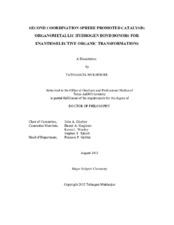| dc.description.abstract | This dissertation describes the development of 2-guanidinobenzimidazole (GBI) containing ruthenium based organometallic hydrogen bond donors and their applications in second coordination sphere promoted catalysis (SCSPC).
The synperiplanar triad arrangement of the NH donor (D) sites in GBI and derivatives are studied to establish that chelation preorganizes GBI in a DDD motif that is not an energy minimum with the free ligand.
Laterhe importance of preorganization is explored in reactions catalyzed by GBI and derivatives. Protonated or methylated BArf (B(3,5-C6H3(CF3)2)4) salts of GBI, 1+BArf– (84%) and 2+ BArf– (58%), are prepared along with the protonated salts ofguanidine and 2-aminobenzimidazole, 3+ BArf– (70% ) and 4+ BArf– (75%),respectively. Refluxing GBI and (η5-C5H5)Ru(PPh3)2(Cl) in toluene forms the chelatedcomplex [(η5-C5H5)Ru(PPh3)(GBI)]+ Cl^- (8+ Cl^-; 96%), which upon addition of COforms [(η5-C5H5)Ru(CO)(GBI)]+ Cl^- (9+ C^-; 91%). Subsequent anion metathesis of 8+and 9+ Cl– gives the respective PF6– and BArf– salts (83-92%). 9+ PF6– can also beprepared from [(η5-C5H5)Ru(CO)(NCCH3)2]+ PF6– (81%). GBI and 9+ Cl– (10 mol%,rt) are ineffective (48 h) for the condensations of 1-methylindole and trans-ß-nitrostyrene (6). In contrast, salts 1-4+ BArf– (25-95%, 1 h) and 8-9+ X– (PF6– andBArf–) are active catalysts (30-97%) under similar conditions.
Furthermore, GBI derivatives with a NHR group (GBI-R; R = 16a, CH2Ph; 16b, (SC)-CH(CH3)Ph; 16c, (RCRC)-CH-(CH2)4-CH-NMe2; 16d, (RCRC)-CH-(CH2)4-CH-NCH2(CH2)3CH2) are prepared. Reactions with [(η5-C5H5)Ru(CO)(NCCH3)2]+ PF6–afford the chiral-at-metal chelates [(η5-C5H5)Ru(CO)(GBI-R)]+ PF6– (18a-d+ PF6–, 39-77%). The Ru,C configurational diastereomers of 18c+ PF6– separate upon alumina chromatography (RRuRCRC, >99:01 diastereomer ratio (dr); SRuRCRC, <2:98 dr). Configurations are assigned by CD spectra, DFT calculations, and a crystal structure. Both (SRuRCRC)-18c+ PF6– and (RRuRCRC)-18c+ PF6– (1-10 mol%) catalyze Michael addition reactions between 1,3-dicarbonyl equivalents and 6 in high yields and enantioselectivities (90-99% ee). The free GBI-R ligand exhibits only modest activity. The chiral ruthenium center has little influence over the product configuration.
Finally, ruthenium GBI complexes bearing a bulky electron withdrawing pentaphenylcyclopentadienyl ligand are accessed by treating a CH3CN suspension of (η5-C5Ph5)Ru(CO)2(Br) with Me3NO•2H2O, GBI, and Ag+ PF6–. Silica gelchromatography workups lead to [(η5-C5Ph5)Ru(CO)(GBI)]+ PF6– (48+ PF6–; 70%),whereas with alumina [(η5-C5Ph5)Ru(CO)(GBI)]+ BArf– (48+ BArf–; 69%) is obtainedafter anion metathesis. The neutral compound (η5-C5Ph5)Ru(CO)(GBI–H) (49; 72%)bearing a deprotonated GBI ligand (GBI–H) is obtained from 48+ PF6– with K+ t-BuO–.These are characterized by NMR, other spectroscopic methods, and X-ray crystallography. Protonation of 49 with the axially chiral enantiopure phosphoric acid, (P)-Phos-H (HOP(=O)(o-C10H6O)2)), leads to (RRu/SRu)-48+ (P)-Phos– (92%) as amixture of Ru,Axial configurational diastereomers. The diastereomer (SRu)-48+ (P)-Phos– (35%) can be isolated with >98:02 dr from cold toluene/hexane. Subsequent anion metathesis provides (SRu)-48+ BArf– (80%). The absolute configuration is assigned by CD spectroscopy. (SRu)-48+ BArf– (10 mol%) is an efficient catalyst for Friedel-Craftsalkylations and Michael addition reactions even under aerobic conditions. The addition of thiophenol to trans-3-cinnamoyloxazolidin-2-one is highly enantioselective (>99%). The neutral complex 49 is even capable of acting as a multifunctional catalyst and promotes Michael addition reaction of diethyl malonate and 6 in the absence of an external base. | en |
| dc.subject | Second coordination sphere promoted catalysis, Catalysis, Enantioselective, Organic transformations, Asymmetric, Chiral, Organometallic, ruthenium, Spectator, Hydrogen bonding, Chiral-at-metal, Resolution, epimer, circular dichroism, absolute configuration | en |


